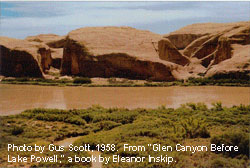 |
|

Extensive changes were brought about on the Colorado River ecosystem by the construction of the Glen Canyon Dam. Most of these alterations negatively affected the functioning of the system and the native aquatic species of the river. The destruction of the Glen Canyon/Colorado River ecosystem has been described as "among the most tragic of environmental losses" (Glen Canyon Institute, 1998). The Glen Canyon environmental studies programs and other research endeavors have produced abundant information on the ecological effects of large dams and have provided impetus not only for restoring the Glen Canyon ecosystem but for halting the further destruction of ecosystems due to the construction of dams.
The reduced supply and transport of sediments is the primary factor responsible for the degradation of the post-dam Glen Canyon ecosystem. When the dam was completed, and the flow of the Colorado River was stifled, sediments traveling along with the river were blocked by the dam and began to build up in what would become the Lake Powell reservoir. In addition, the few sediments which enter the Colorado river from downstream tributaries are transported very inefficiently due to the limited amount and velocity of water flow. The severe decline in coarse organic matter moving through the downstream portion of the river has had many deleterious consequences for the species of the ecosystem. Three species of fish, the Colorado squawfish, the roundtail chub, and the bonytail chub, have become extinct, and five more are endangered, in part due to the sediment free water flowing evenly out of the dam and the associated extreme drop in water temperature (USBR and USDOI, 1996). Many species of fish, amphibians, and insects use sediments for habitats, spawning ground, and protection, and without these resources these species are greatly imperilled.
With the building of the dam, natural seasonal flow variations were substituted for significant daily fluctuations, and this had a significant impact on the water quality of the river and, therefore, the species of the river. For example, the natural temperature range of the water (~32 F-80 F) instead became a relatively constant temperature of 46 F (USBR and USDOI, 1996). This low temperature has, among other things, impeded reproduction by the warm water species of the Colorado River, thereby shifting species composition and reducing biodiversity.
Obstructing the free flow of the Colorado River has significantly reduced its water quality. In fact, the Department of the Interior has indicated that the river is of one of the poorest water qualities in the nation (Ingebretsen, 1998). The river downstream of the Glen Canyon Dam is practically devoid of nutrients because most of these are bound to sediments, and therefore they never leave the reservoir. In addition, otherwise harmless trace metals and salts, such as selenium, arsenic, and mercury, when trapped in stationary sediments can be converted into detrimental forms. These then become incorporated into plankton and zooplankton, and are distributed throughout the food web.
Other ecological problems resulting from the Glen Canyon Dam are associated with non-native species entering the ecosystem. There was a diverse assemblage of species inhabiting the pre-dam Glen Canyon riverine system, but in many cases these native species have been stressed, and in some cases desolated, by the introduction of exotic species. Various species of trout and other game fish, like striped, large, and small mouth bass, black crappie, walleye, bluegill sunfish, and channel catfish (NPS, 1998) have been introduced into Lake Powell and the Colorado River, and these and other generalist species often out compete weakened endemic species which are often specialists whose specific niche has been destroyed.
The riparian vegetation downstream from the Glen Canyon Dam has been seen to proliferate in the early years after the dam was built (USGS, 1996). The reason vegetation is able to grow in more abundance on the sandbars and canyon walls is due to the Colorado River not having seasonal flooding (USGS, 1996). The plant diversity along the corridor significantly increased as a result of the alteration of the Colorado River. As the years passed, the sandbars have been eroding because the river is unable to provide the strength and silt to move and create sandbars. In 1996, an artificial flood was created to help solve the problem of eroding sandbars. On March 26, 1996 the Dam began releasing a total of 360,000 acre-feet of water (Brinkley, 1996). The flood was successful in repairing many of the sandbars by providing the flow and sediment concentration to rebuild them (Brinkley, 1996).
One study of the controlled flooding found that the volume of sand stored in the re-circulation zones increased because the sand was redistributed from the river bed to eddy sand bars (Hazel, 1997). The sandbar volumes increased significantly (49%) which caused them to be higher, but the width was not significantly increased (Hazel, 1997). The effects seen six months after the flooding on the sandbars found that erosion was taking place with a much greater rate higher up the river near the dam. The eroding sandbars were depositing the sand in eddies which caused eventual filling but the sandbars did not erode so much as to become smaller than before the flooding (Hazel, 1997).
The effect of the gradual decline of the riparian zones over the years has put stress on some species of animals. The southwestern willow flycatcher populations along with other populations of birds have declined from the controlled flow of the Colorado River (USBR and USDOI, 1996). The riparian vegetation, which is slowly disappearing, is the habitat for the animals (Bureau Of Reclamation, 1996). More detailed information on the species problems is available through the Lower Colorado River Multi-Species Conservation Program.
 |
|